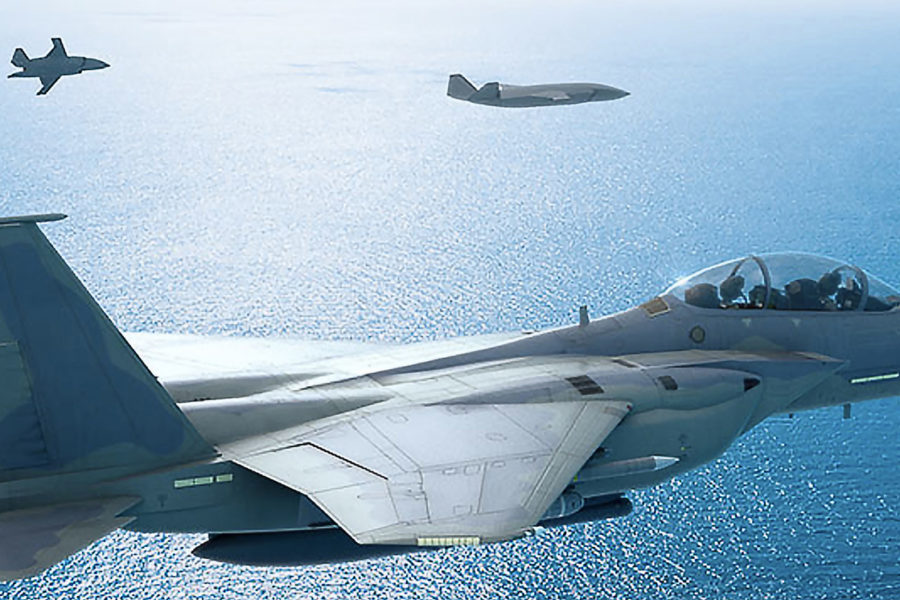FARNBOROUGH, U.K.—As the Air Force moves forward with plans to team manned and unmanned systems in the future, the service might be best served by pursuing platforms that can function on their own as uncrewed aircraft—but are still capable of working as “loyal wingmen” to manned systems.
So said several executives of top defense contractors at the Farnborough International Airshow this week, emphasizing flexibility in how these new aircraft would be able to operate.
The question of how the Air Force should approach the concept of manned-unmanned teaming has been an open one. Air Force Secretary Frank Kendall has endorsed the idea of unmanned combat drones, designed to work with manned aircraft and “run plays” called by the pilot. He’s also called for up to five drones to fly alongside fighters.
Other ideas proposed have run the gamut—some have focused on just one “loyal wingman” to extend a fighter’s sensing range or potentially carry more weapons, while others have called for swarms of drones to go with each jet, each performing different functions. Some are based around the drones being autonomous, functioning independently, while others envision the drones performing preprogrammed tasks as directed.
“The Air Force has made comments around ‘loyal wingman’-type operations, manned-unmanned aircraft. We’re fully engaged with that,” Boeing Phantom Works vice president and general manager Steve Nordlund told reporters. “Our concept around that is it’s not about a platform and surrounding that platform with a swarm of UAVs. We believe in swarm technology. What we really want to do is be untethered from the platform and to be able have the autonomous vehicle go where it’s needed, regardless of where the platform is.”
Such an approach would provide “flux ability” for operators, Nordlund added.
“So if there’s an aircraft in a different vicinity that has a need, … the unmanned system can respond to that,” said Nordlund. “So that interoperability piece becomes really important; the level of quantity becomes really important; how that handoff happens is really important. So those are a lot of the things we’re working on, both procedurally as well as the technology.”
Nordlund’s endorsement of an “untethered” system echoes comments made by John Clark, the new head of Lockheed Martin’s Skunk Works program—earlier this month. Clark said the company had done analysis that determined that the best approach was a “distributed” team with uncrewed aircraft working in a “detached” way.
But Nordlund went further in saying the system should be set up so that the uncrewed aircraft can still come back to the manned one and act as a “loyal wingman” if needed.
“I want the flexibility to be able to serve that mission that is at hand that day and be able to do both of those. Tethered when it needs to be tethered, untethered when it needs to be untethered, is what I think our customer would desire to see,” Nordlund said.
One of the contractors that has frequently been connected to the “loyal wingman” concept is Kratos. Its Mako and Valkyrie unmanned aircraft have been tested as part of the Air Force’s Low-Cost Attritable Aircraft Systems and Skyborg platforms, demonstrating key characteristics such as autonomy, affordability, and the ability to fly alongside manned fighters, translating data.
And Jeffrey Herro, a senior vice president in Kratos’ unmanned systems division, also endorsed the idea of the drones being able to function on their own and within a teaming concept.
“I view these systems like we have as yet another tool in the arsenal of the pilot in command of a manned aircraft,” Herro said. “You might say this is another airplane. Well, it is, but it is actually just another toolset in his cockpit, potentially. It just happens to be off board in another airplane. … That’s one way to do it. These things can also be reasonably more autonomous and a standalone system to accomplish particular mission sets.”
Such flexibility could offer intriguing opportunities when it comes to planning and executing operations, added Robert Winkler, vice president of Kratos’ corporate development and national security programs.
“I think it’s really important, that idea of disaggregating sensors and platforms for a disaggregated strike package,” Winkler said. “And [then] it comes together at the right time. It doesn’t have to launch from the same location, but you can make that package on the fly.”

